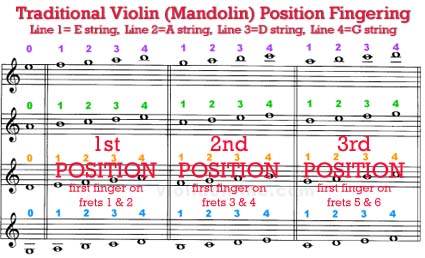JazzMando.com Tips and Tricks
Those who come from a classical violin background (or classical mandolin for that matter) might well question the difference in approach to understanding the mandolin fretboard. We've received questions and have even noted an occasional discussion forum tackle the subject. Time to weigh in publically.
For the uninitiated, the traditional "Positions" is based on a violinist referencing all strings in relation to the "open position" where the first finger covers the equivalent of the first two half-steps (frets if there were...), second finger covers the next two, third & fourth, etc. From the mandolin fretboard equivalent each of the four fingers is responsible for the first 6 frets in open or 1st Position (I). This is a critical understanding for beginning violinists who are not only grappling with learning the vocabulary of the notes themselves, but "tuned" notes. It's hard enough learning the nuance of half and whole steps, as the player moves around the circle of keys, one discovers the magnificent world of "just tuning." Without going into a lot of whole theoretical detail here, let's just say the orchestral world is able to take advantage of "perfect" tuning, but in the piano and fretted world, we compromise with the Equal Temperament tuning. (At best, we are always theoretically playing ever so slightly out of tune.)
Beginning violinists depend heavily on the tactile understanding of the fingerboard, each finger in reference to the one before it. It's like finding your way through a dark hall with your feet. Knowing how many footsteps it is in a certain direction when you can't see can keep you from bumping into things.
Now what happens when a violinist wants to advance to higher notes? They move everything up like an elevator, but it's all referenced to the player's first finger in "Positions." The formal understanding of 2nd Position (II) is that the first finger is based on the E string, on the G string a B (or Bb).
From the chart above you can see the 3rd position (III) starts everything on the equivalent of the 5th fret. Of course you've got half steps and other positions to get to eventually (IV, VI, VII), but you get the idea. Everything is referenced to a hypothetical first finger base. This is quite similar to the Don Stiernberg Ab system we've mentioned in the past.
This has worked centuries for violin pedagogy in the past, and there's no reason it shouldn't work for a mandolinist as well. Its benefits include a better understanding of the vertical nature of the fretboard (moving up the length of the string and not just across to more strings), and access to different tonal qualities of the fretboard. Orchestral instruments have a warmer tone up the string (as does the mandolin) and better expressive opportunity for vibrato.
So what about FFcP? Understand the emphasis on the approach of using all four fingers as the base can give you more opportunity in a limited area of the fretboard. You also have more opportunity in shifting tonal centers not being forced to move up the fretboard just to play in a different key. Unencumbered by the need to strive for just intonation (where frequencies of notes are related by ratios of whole numbers), you aren't as tied to the fretless world of perfect tuning (for better or worse). It's also much friendlier to the horn keys of Bb, Eb and F, let alone those dark keys on the dank enharmonic equivalent end of the circle of keys, C#/Db, F#/Gb, and B/Cb.
Which is better, Positions or FFcP? This is like asking what tool is better for building a house, a hammer or a saw? Both are implements to get a different aspect of the same job done. You really need a combination of both. Limiting yourself to just one area of the fretboard in FFcP denies you rich tonal variation. Moving up the fingerboard for every key or tonal center change is hardly an efficient use of movement either, so we recommend using both.
We recommend hovering around the 3rd and 5th Positions as home base in jazz, but with a good set of FFcP skills. You can always move things back down a few frets, and occasionally, use the open string for "tricks" and covering position shifts. For a great challenge, take tunes you already know and try to base them in this area of the fretboard. This is a wonderful exercise for reading through familiar songs of the Real Book.
Further:
FFcP Index
FFcP Moving on Up
The Ab Position
Violin Online Advanced Fingering Chart 1st--7th Positions
Visit JazzMando.com web site...









 Reply With Quote
Reply With Quote
Bookmarks